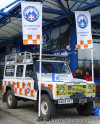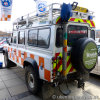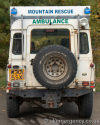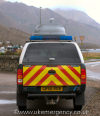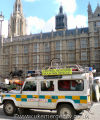Category: Rescue
YP58 HBF Mines Rescue have this Ford Transit as the ‘first away’ emergency response …

YP58 HBF Mines Rescue have this Ford Transit as the ‘first away’ emergency response vehicle at Kellingley Mine. It is fitted with two blue light bars on the roof as well as repeaters in the front grille.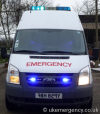
The front, showing how it would be seen in your rear view mirror. In addition to the blue flashing lights are wig-wag headlights.
The rear, showing the smart livery and high-visibility chevrons.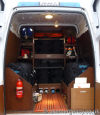
In the back is an array of equipment including breathing apparatus, stretcher and lighting.
The vehicle on stand-by outside the rescue station.
FH07 OES Leicestershire FRS use this silver Ford Transit Connect as an Urban Search…

FH07 OES Leicestershire FRS use this silver Ford Transit Connect as an Urban Search and Rescue Dog Unit. The Leicestershire International SAR Team has two dogs and two dog handlers that are used in the UK and overseas.
The rear view. The van is air conditioned for the dogs’ comfort. The unit has seen service at building collapses, major transport incidents, explosions, construction accidents, and natural disasters.
G-CIAS Channel Islands Air Search operate this 1982 Islander aircraft …

G-CIAS Channel Islands Air Search operate this 1982 Islander aircraft for Search and Rescue work (with personalised registration). CIAS is a 24/7 charity that assists in saving lives at sea and is supported entirely by volunteers. The Channel Islands are a distance away from government-funded French and English rescue helicopters and so created their own service in 1980.
The aircraft in its purpose built hanger on Guernsey. It was built in 1982 and came to the service in 1992 with many modifications made. These include extended nose housing for radar, extended wing tips and long range fuel tanks.
Another view of G-CIAS ready for action. With callsign ‘Airsearch One’, it can travel at up to 140 knots and can stay in the air for up to 4 hours 30 minutes. It carries out sea and land searches, including mainland France and England.
The rear view of the aircraft called Lions’ Pride. It can take off with just 100m visibility and the time from call to airborne is about 25 minutes. This includes the time taken for the volunteers to drive to the hanger – a journey that is helped by the use of green flashing lights on their private cars.
The Forward Looking Infa Red (FLIR) pod shown cost £200,000 to purchase and was a massive sum to pay out for a small charitable organisation. However the benefits of having this save lives.
The underside of the aircraft as seen from the sea. The charity use the tag line ‘The Lifeboats’ Eyes in the Sky’.
A close look at the four speakers used as a public address system or siren.
Inside the aircraft. This compact space is for five team members: a pilot, a search director and observers. There is no capability to rescue or transport casualties.
The rear observer seats. The windows are bulged outwards to allow the observers to look straight down. A small chute at the bottom of the photograph allows sea flares to be placed on the sea as markers. Behind the rear seats is an inflatable life raft that can the pushed out of the aircraft to be used by up to 11 people in the sea.
In this staged photograph, G-CIAS is in flight, joined by the Channel Islands’ other rescue services.
In this set of images we can see some of the vehicles used for a major MR incident…

In this set of images we can see some of the vehicles used for a major MR incident. A walker on Ben Nevis has been reported missing for nearly two days. The 20-year old man was ill-equipped for walking the hill and was last seen at 3,300 feet wearing jeans and a jacket.
All of the vehicles shown in this line up are RAF mountain rescue from Kinloss and Valley. Around 50 people were involved in the search that was hampered by darkness and severe weather.
SF52 OTR A close up look at one of the RAF MRT Mercedes Sprinter vans.

Also in attendance are Lochaber MRT with this Ford Transit personnel carrier.
Royal Navy helicopter RESCUE 177 is also involved with a couple of Northern Police dog handlers. SARDA Scotland were already at work up the hill.
The helicopter circles with the door open as the winchman and winch operator scour the landscape for the walker. Unfortunately, six days after the walker disappeared, his body was found.

